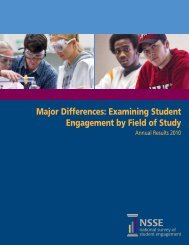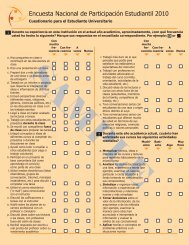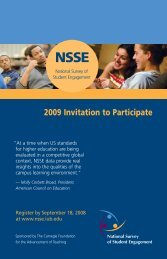Conceptual Framework and Overview of Psychometric Properties
Conceptual Framework and Overview of Psychometric Properties
Conceptual Framework and Overview of Psychometric Properties
Create successful ePaper yourself
Turn your PDF publications into a flip-book with our unique Google optimized e-Paper software.
<strong>Psychometric</strong> <strong>Properties</strong> <strong>of</strong> the NSSEValidity is arguably the most importantproperty <strong>of</strong> an assessment tool. For this reasonthe Design Team that developed the NSSEinstrument devoted considerable time during1998 <strong>and</strong> 1999 making certain the items onthe survey were clearly worded, well-defined,<strong>and</strong> had high face <strong>and</strong> content validity.Logical relationships exist between the itemsin ways that are consistent with the results <strong>of</strong>objective measures <strong>and</strong> with other research.The responses to the survey items areapproximately normally distributed <strong>and</strong> thepatterns <strong>of</strong> responses to different clusters <strong>of</strong>items (College Activities, Educational <strong>and</strong>Personal Growth, Opinions About YourSchool) discriminate among students bothwithin <strong>and</strong> across major fields <strong>and</strong>institutions. For example, factor analysis(principal components extraction with obliquerotation) is an empirical approach toestablishing construct validity (Kerlinger,1973). We used factor analysis to identify theunderlying properties <strong>of</strong> student engagementrepresented by items on The Report. These<strong>and</strong> other analyses will be described in moredetail later.The degree to which an instrument is reliableis another important indicator <strong>of</strong> aninstrument=s psychometric quality. Reliabilityis the degree to which a set <strong>of</strong> itemsconsistently measures the same thing acrossrespondents <strong>and</strong> institutional settings. Anothercharacteristic <strong>of</strong> a reliable instrument isstability, the degree to which the studentsrespond in similar ways at two different pointsin time. One approach to measuring stabilityis test-retest, wherein the same students areasked to fill out The Report two or more timeswithin a reasonably short period <strong>of</strong> time. Veryfew large-scale survey instruments have testretestinformation available due to thesubstantial expense <strong>and</strong> effort needed toobtain such information. It=s particularlychallenging <strong>and</strong> logistically problematic for anational study <strong>of</strong> college students conductedduring the spring term to collect test-retestdata because <strong>of</strong> the amount <strong>of</strong> time availableto implement the original survey <strong>and</strong> then inthe short amount <strong>of</strong> time left in the term tolocate once again <strong>and</strong> convince respondents tocomplete the instrument a second time.Estimating the stability aspect <strong>of</strong> reliability isproblematic in two other ways. First, thestudent experience is somewhat <strong>of</strong> a movingtarget; a month=s time for some students canmake a non-trivial difference in how theyrespond to some items because <strong>of</strong> what=stranspired between the first <strong>and</strong> secondadministration <strong>of</strong> the survey. Second, attemptsto estimate the stability <strong>of</strong> an instrumentassume that the items have not changed orbeen re-worded. To improve the validity <strong>and</strong>reliability <strong>of</strong> The Report, minor editing <strong>and</strong>item substitutions have been made prior toeach administration. We=ll return to thesepoints later.Two additional pertinent indicators areestimates <strong>of</strong> skewness <strong>and</strong> kurtosis. Skewnessrepresents the extent to which scores arebunched toward the upper or lower end <strong>of</strong> adistribution, while kurtosis indicates theextent to which a distribution <strong>of</strong> scores isrelatively flat or relatively peaked. Valuesranging from approximately + 1.00 to - 1.00on these indicators are generally regarded asevidence <strong>of</strong> normality. For some items, out<strong>of</strong>-rangeskewness values can be expected,such as participating in a community-basedproject as part <strong>of</strong> a regular course where,because <strong>of</strong> a combination <strong>of</strong> factors (major,course selection, faculty interest), relativelyfew students will respond something otherthan Anever.@To establish The Report=s validity <strong>and</strong>reliability we’ve conducted psychometricanalyses following all six administrations <strong>of</strong>the instrument, beginning with the field testsin 1999. These analyses are based on 3,226<strong>Framework</strong> & <strong>Psychometric</strong> <strong>Properties</strong>Page 5 <strong>of</strong> 26



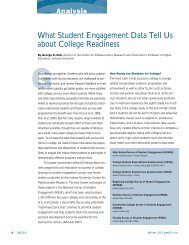

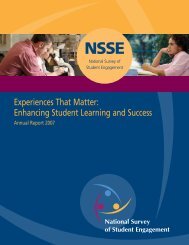
![Cuestionario para el Estudiante Universitarioâ[consent] - NSSE](https://img.yumpu.com/41728892/1/190x245/cuestionario-para-el-estudiante-universitarioaconsent-nsse.jpg?quality=85)
